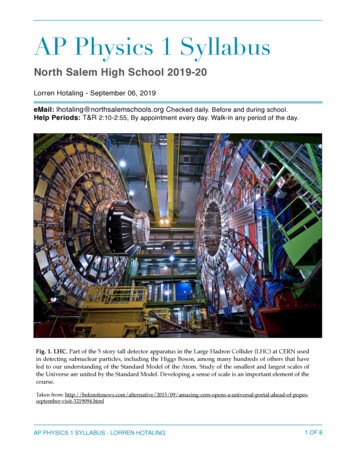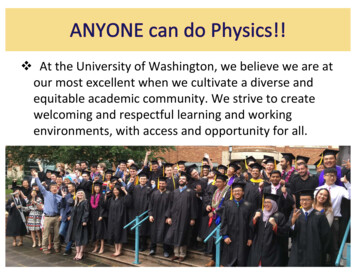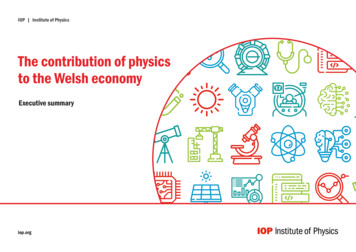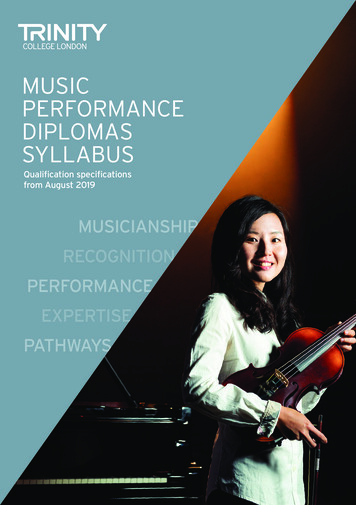
Transcription
AP Physics 1 SyllabusNorth Salem High School 2019-20Lorren Hotaling - September 06, 2019eMail: lhotaling@northsalemschools.org Checked daily. Before and during school.Help Periods: T&R 2:10-2:55, By appointment every day. Walk-in any period of the day.Fig. 1. LHC. Part of the 5 story tall detector apparatus in the Large Hadron Collider (LHC) at CERN usedin detecting subnuclear particles, including the Higgs Boson, among many hundreds of others that haveled to our understanding of the Standard Model of the Atom. Study of the smallest and largest scales ofthe Universe are united by the Standard Model. Developing a sense of scale is an important element of thecourse.Taken from: tember-visit-3219094.htmlAP PHYSICS 1 SYLLABUS - LORREN HOTALING1 OF 8
Overview of AP Physics 1AP Physics 1 is a standards based physics course based on the 2015 course outlineproduced by the College Board. It is designed to reflect the most current thinking about theteaching and learning of Physics with a heavy emphasis on laboratory work through inquiry.The course culminates in the AP Physics 1 exam taken in May. Because of the scope of thesubject matter in AP Physics 1, students are not prepared to take either the Physics SAT 2 if orthe Physics Regents Exam in late June.The AP ScoreMultiple Choice90 minutes50%Free Response/Short Answer90 minutes50%A composite score is provided to students in July by the College Board.AP Physics 1 is perhaps the single most important course in preparing students forcollege study of all the sciences: Biology, Chemistry, Physics, Earth and Space, Meteorology,Engineering, and Medicine, among others. It should also be viewed as a prerequisite coursefor any science course in college.AP Physics 1 is intended to be taken as a first year course in Physics, but requires asolid foundation in algebra. The new AP Physics 1 course is very different from the old APPhysics B course which it replaced and other typical calculation heavy physics coursesexperienced by most students in America past and present. It is instead, an exam focused onthinking, reasoning, and applying physics concepts to situations and writing clearly justifiedexplanations.AP PHYSICS 1 SYLLABUS - LORREN HOTALING2 OF 8
North Salem High School AP Physics 1 CurriculumThe Course Syllabus Outline is designed to cover the entire AP Physics 1 curriculum.It is not geared to prepare students for either the SAT II in physics or the NYS PhysicsRegents Exam.Topic 1: Measurements and uncertainties1.1 – Measurements in physics1.2 – Uncertainties and errors1.3 – Vectors and scalarsTopic 2: Mechanics2.1 – Motion2.2 – Forces2.3 – Work, energy and power2.4 – Momentum and impulse2.5 — Circular Motion and GravitationTopic 3: Simple Harmonic Motion, Mechanical Waves, and Sound3.1 – Oscillations3.2 – Travelling waves3.3 – Wave characteristics3.4 – Wave behaviour3.5 – Standing wavesTopic 4: Electric charge, Electric Force, and DC Circuits4.1 – Electric fields4.2 – Heating effect of electric currents4.3 – Electric cells4.4 – Magnetic effects of electric currentsTopic 5: Torque and Rotational Motion5.1 — Rotational kinematics5.2 — Rotational inertia5.3 — Rotational energy5.4 — Rotational momentumAP PHYSICS 1 SYLLABUS - LORREN HOTALING3 OF 8
AP Exam ResultsWhile it may seem that AP results , which represent academic rigor, should becomparative across courses, analysis of different AP exam results presents a complicatedpicture. The table below shows the distribution of AP Exam results (scores 1-5) and numbersof exam papers written. Nationally, AP Physics 1 has the lowest overall score performance ofany of the most commonly administered exams. Students are provided the opportunity toexperience all of the subject matter and skills required of the AP Physics 1 Exam. However,high scores cannot be achieved without significant practice of the right kind.Course% ofstudentsscoring 1% ofstudentsscoring 2% ofstudentsscoring 3% ofstudentsscoring 4% of% 3 orstudents higherscoring 5# ofstudentsAP Biology10293322764254270AP Calculus AB202221171958316099AP Calculus BC51521194081132514AP Chemistry212425171752158931AP English:Lang. & Comp17362715655579426AP Env. Science26261524949159578AP Physics 131292015542170447AP Physics 29313515116524985AP Physics C -M10132128297954862AP Physics C -E11171423357124249AP Statistics231625211454215840AP PHYSICS 1 SYLLABUS - LORREN HOTALING4 OF 8
Grading and AssignmentsExams and Quizzes:40-60%Laboratory and Projects:40-60%Exams: will be given every 2-3 weeks and consist of AP, IB, and SAT 2 items scored using AP scoringguidelines. AP scores will then be converted to letter/number grades.Quizzes and miniquizzes: will be given almost daily and will focus on basic declarativeknowledge and fundamental skills which are the building blocks for doing AP questions. Students areprovided with many sets of flash cards for daily practice. Quizzes may also be the subject of aparticular night’s assignment or project. Students will have the opportunity to repeat most quizzes toreplace their score and achieve mastery. (See my blogpost about Mastery Learning)Laboratory Investigations: comprise 50 % of the instructional time in the course to reflect theirweight in the AP score. They consist of Lecture Demonstration Labs, MiniLabs, Typical Labs, andDesign Labs. Labs are modeled after AP questions so students will develop a hands experience withthe many and varied AP questions. Students are expected to collect their own data and complete andsubmit their own reports unless otherwise specified. If in any quarter it is deemed that a student hasnot made adequate progress toward completion of practical work, s/he will receive a failing grade forthat quarter, irrespective of mathematical or exam average.iLabs and PVA Labs: iLabs are laboratory inquiries designed to be completed at home often usingsimulation software. Approximately 1 will be assigned each week. Physics with video analysis labs(PVA) will also be assigned often and are designed to be completed at home and in the lab.Presentations and other projects: Developing communication skills is critically important to theAP program as a whole and is especially important in the Experimental Sciences. Students willengage in up to 2-3 formal presentations per marking period, make infographics and write articles fora North Salem Physics magazine. Students will also make formal and informal technical presentationson solving physics problems.Homework: Students will have daily homework assignments that will include KhanAcademy videos, reading, and problem sets, in addition to the above type of assignments. Allwork is geared toward learning. Students are encouraged to challenge anything that isdeemed to be “busy work.” Students should expect to spend at least 60 minutes per day, 6days per week. Most top students spend significantly more.AP PHYSICS 1 SYLLABUS - LORREN HOTALING5 OF 8
Daily AP Physics Study RegimenThe daily homework is posted in Google Classroom. The format of the varied activitiesare designed to promote long term retention and preparation for class and laboratory activity.Over the years this has been shown to be an incredibly successful model for this AND othercourses. It also serves to save students time overall and reduce stress levels. The assignmentseach day are laid out in this order.Activity in order of priority and explanationSuggestedtimeGet Organized: put binder in order with oldest items on the bottom. Update your ToDo listin the course, assignments, and due dates.5Flash Cards: Keep a running list of flash card sets, select several sets to work on, including amix of ones that are a) new b) old and c) you do not know well yet. Keep track of yourprogress in terms of mastery: a) front side in order b) back side in order c) mix of front andback in order d) front side mixed order e) back side mixed order f) mix of front and back inmixed order. It is much better to do this for 5-10 minutes EVERY day than it is to do it for anhour on a particular day. Mastering this information will allow you to understand lessonsbetter, do better on homework, be more facile in the laboratory, be able to estimate whenyou’ve made a mistake on a problem, and answer declarative knowledge questions that areasked by the AP.5-10Review Class Notes: Review the day’s class notes to see what you can follow on your own.Identify places where you didn’t understand or follow what you did to ask your classmatesor me the next day. Add items to your flash card set on RATN from the night before. It is notnecessary to re-copy your notes.10-15KHAN: Read and take notes on the assigned text. Highlight and underline key terms andconcepts. Flag items you don’t understand to ask about in the lesson the next day or come into ask about. Start a set of flash cards from the reading that you can add to the notes ontomorrow’s class. It is incredibly important to be exposed to material multiple times to bestunderstand it. Read first, get the lesson, apply it, review it. Reading first truly preps you toget the most out of the less for the next day.20-30Problem Set: Do your problem set neatly in your problem notebook. Be sure to follow theprocedures for problem solving that are given. It is not OK to say “I don’t know how to doit.” What did you try? Show it. Draw pictures, highlight and underline, separate variables,write down equations, try things, write down questions.20-40PreLab: Do the PreLab thoroughly so you are a collaborative asset for your partner. We willalways be pressed for time. Do them thoroughly and take note of questions you have foryour partner and for me. I will not help you with the Lab or may not allow you to start theLab if you have not completed the preLab thoroughly.10-20 Long-Term Projects: These include your presentations, Labs, vLabs, iLabs, PVAs,AP PHYSICS 1 SYLLABUS - LORREN HOTALING15 6 OF 8
Student and Parental Support and CommunicationAs the year progresses on Fridays I will send an eMail blast to parents if there is an importantassignment that has been missed, an exam or quiz score that is poor, and/or updates aboutwhat is going on in the classroom. Although juniors — and especially seniors — should beable to manage this communication with parents, the transition to the senior year can causestudents to quickly fall far behind. This makes quick intervention essential.eSchool: at progress report time I will provide estimated component marks, grades, andpredicted AP scores. Please eMail me at any time for individual qualitative feedback or anupdate on your son or daughter.Students who are historically most successful come in frequently with brief, specificquestions. This is a behavior that all of the very best students I’ve had over the last 25 yearsdo. Long help sessions should not be necessary and are indicative of a lack of regular study.AttendancePassing time is 4 minutes long. I allow students an additional 2 minutes before consideringthem late. During this time I expect them to come prepared, having gone to the bathroom,etc. and ready to do some serious physics. Each class begins with an open ended activity“Opener” which students can start as soon as they arrive.AP PHYSICS 1 SYLLABUS - LORREN HOTALING7 OF 8
Supplies and ResourcesTextbooks:College Board. (2019) AP Physics 1 Workbook. New York: The College Board.Etkina, E. et al. (2015) College Physics. AP Edition. Boston: Pearson Education, Inc.Homer, David, and Michael Bowen-Jones. (2014) IB Physics Course Book. Oxford: OxfordUniversity Press. (Print and online editions provided.) Kindle version available.Jacobs, Greg. (2018) AP Physics 1: Algebra-Based. 5 Steps to a 5. New York: McGraw Hill.Kirk, Tim. (2014). IB Physics Study Guide 2014 edition. Oxford: Oxford University Press. (Printand online .pdf versions provided.) Kindle version available.Taylor, John R. (1997). An Introduction to Error Analysis: The study of uncertainties in physicalmeasurements. 2nd ed. Sausalito: University Science Books. (.pdf version provided).Tsokos, K.A. (2016) Physics for the IB Diploma Exam Preparation Guide 2nd ed. Cambridge:Cambridge University Press. (Print and online editions provided.)Tsokos, K.A. (2014) Physics for the IB Diploma Coursebook, 6th ed. Cambridge: CambridgeUniversity Press. (Online edition provided and print version available.)Supplies:-2 composition books-Protractor 1 increment with cm ruler-Mechanical Pencils-Black Pens-USB Thumb Drive-TI-84 (or higher) Graphing CalculatorAP PHYSICS 1 SYLLABUS - LORREN HOTALING8 OF 8
The Course Syllabus Outline is designed to cover the entire AP Physics 1 curriculum. It is not geared to prepare students for either the SAT II in physics or the NYS Physics Regents Exam. Topic 1: Measurements and uncertainties 1.1 - Measurements in physics 1.2 - Uncertainties and errors 1.3 - Vectors and scalars Topic 2: Mechanics 2.1 .










